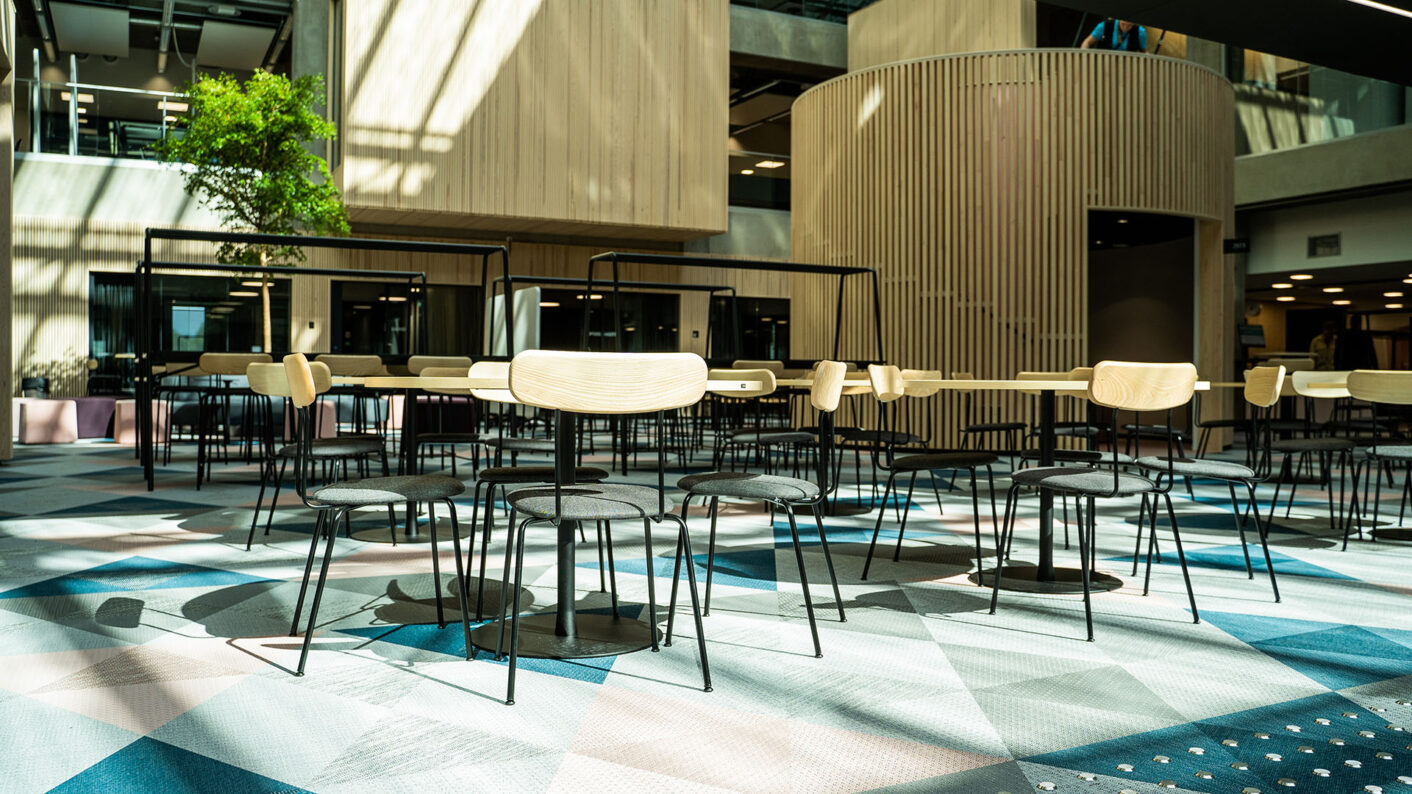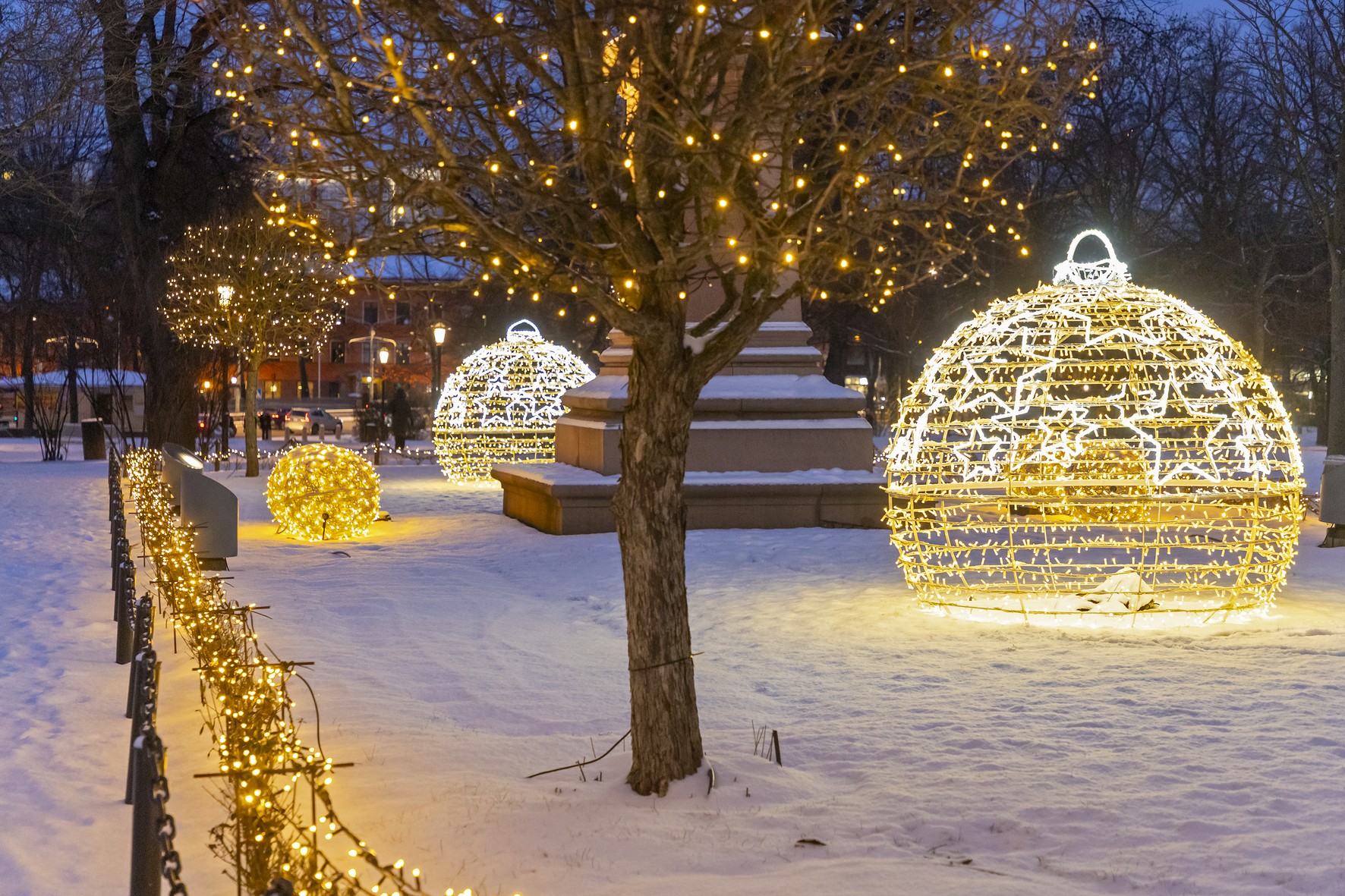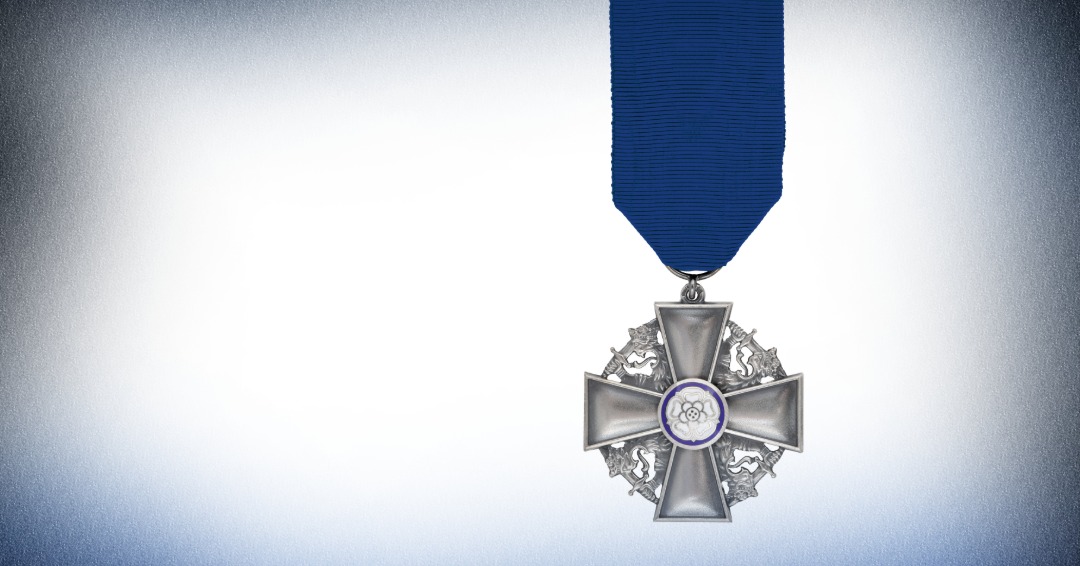The meeting and group work spaces in the new EduCity building on the Kupittaa campus are named after people and things from the history of the Kupittaa area. In this way, history meets the future as students learn about influential figures and events in the area through the stories on the signage.

Published:
Edited:
At our request, the history of the area has been researched by historian Veli Pekka Toropainen. He has also compiled a compendium, “The Cupola of Centuries”, which gives a good overview of the history of the area.
Centuries of Kupittaa
1100
Kupittaa is mentioned as the place where, according to tradition, during the crusade of St Erik and St Henry, Bishop Henry baptised Finns into Christianity at the Kupittaa spring.
1500
Kupittaa became the scene of two battles or skirmishes, as the Danish conquerors were expelled from Finland and power struggles between the kings of Vaasa took place. Kupittaa also saw more peaceful contests: the Duke of Turku, who hosted Turku Castle, ordered his vassal to build a tournament arena there for his court.
1600
The Crown donated the Kupittaa area to the City of Turku. It was divided into parcels or plantations, which the city’s bourgeoisie could rent for farming and grazing their cattle. The tobacco plantations in the area provided a rich source of raw material for the manufacture of malt.
Already in the 17th century, Kupittaa served as a recreation area for the townspeople outside the city proper. Students from the Turku Academy also wandered there on Flora’s Day to drink plenty of wine and schnapps and celebrate the arrival of spring.
The beneficial effects of the waters of the Kupittaa health spring were understood in the late 17th century.
1800
The well-drinking of the Kupittaa spring, as the drinking of water was called, flourished. Bottled water was also sold elsewhere, so the appreciation of Kupittaa water spread far and wide.
Kupittaa is thought to be the site of the country’s first public park for city dwellers. Villas were built on the plots. They were used as restaurants, where dinners, circuses and light shows were held. Kupittaa became an oasis of pleasure for Turku’s residents, with restaurants attracting visitors with their exotic gardens and names. The area was home to the Alhambra, for example.
The country’s first garden school and commercial gardens operated in Kupittaa until the 1900s. Kupittaa’s spa activities ended in 1885, when the oldest spa building burnt down, the second was auctioned and later demolished.
1900
The spa’s ballroom remained unused until the Winter War, when it burned down. What remained was the octagonal departure pavilion, which now stands next to the pitch next to the Kupittaa ground swimming pool.
The 1900s brought new activities to Kupittaa with the racecourse, Turku’s first open-air swimming pool, a bird pond and sports facilities.
The stories behind the names of the spaces
St Henry (1100s). According to legend, Henry, the first bishop of Finland, baptised Finnish pagans into Christianity at the fountain of Kupittaa during his crusade with Swedish King Erik.
Charles the Duke (1550-1611). He seized power from his nephew Sigismund, King of Sweden and Poland. He ruled under the name Charles IX. In early September 1597, fought a battle at the fountain of Kupittaa against Finnish troops loyal to Sigismund and drove them into exile.
Erik Fleming (1487-1548). One of Finland’s most prominent noblemen and a confidant of King Gustav Vasa. When the Danes had conquered Turku, they had a defensive position at Kupittaa. In 1523, the Fleming brothers expelled the Danes from this position to Turku Castle.
Ivar Fleming (c. 1490-1548). Together with his brother Erik Fleming, he led the troops that drove the Danish conqueror from his camp at Kupittaa in 1523. The battle was part of the events leading to Sweden’s independence from the Nordic confederation.
Elias Tillandz (1640-1693). The father of Finnish botany and the first professor of the Academy of Turku to have received a proper medical education. He studied the medicinal value of the water from the Kupittaa spring and built a well room for drinking the water.
Johannes Ekelund (1712/1713-1746). The first physician and doctor of medicine to graduate from the Medical Faculty of the Academy of Turku. His thesis was entitled ‘Examen Chymico-Medicum fontis soterii Kuppisensis’. It described the properties of the water of the Kupittaa health spring and the diseases for which the water had been successfully used.
Josef Bremer (1743-1814). Merchant and potter from Turku. Bremer was a partner in the brickworks established in 1763 in Kupittaa, the raw material for which came from the area. The brickworks was the predecessor of Kupittaan Sava, which operated from 1921 to 1969.
Matias Augustin (1746-1808). One of the richest merchants of his time in Turku. Augustin was a partner in the Kupittaa brickworks, founded in 1763. It employed 20 people and in 1770, for example, it produced 48 000 pieces of roof tiles and 101 500 pieces of masonry bricks.
Carl Christian Böcker (1786-1841). Long-time secretary of the Finnish Economic Society, who developed its activities. Böcker also promoted potato cultivation in Finland and leased land from Kupittaa for cultivation. The area around the present-day colonial garden was called Böcker’s Kupittaa.
Evert Julius Bonsdorff (1810-1898). Archaeologist and one of the most important doctors of his time in Finland. From 1853 Bonsdorff was the head of the Kupittaa health fountain. He stressed the importance of water cure as part of other treatments, but criticised the fanatics who believed in water cure alone.
Frans Wilhelm Avellan (1813-1878). Doctor of medicine and surgery, Turku city physician, professor. Avellan was the director of the Kupittaa health fountain from 1846 to 1853. He was also a member of the Finnish Literary Society from 1855 to 1878.
Lovisa Almberg. A Swedish-born restaurateur at the Ringsberg Villa, later the Moriaberg Villa, near the junction of the present Uusimaa Road and Hippoksentie. Provided accommodation and meals for guests of the Kupittaa Health Fountain.
Helena Forselius. Continued as a restaurateur at Ringsberg’s villa after restaurateur Lovisa Almberg moved her catering business to merchant Abraham Kingelin’s villa in Moriaberg in the late 1830s. Ringsberg’s villa, also known as the brothel, burnt down in 1880.
Katri Tätilä (1905-1980). Katri Tätilä from Turku was one of the most important Finnish women artists of the post-World War II period. In addition to her painting and graphic work, she produced monumental works and used her skills as a designer in the ceramics department of the Kupittaa Saviosake company.
Kerttu Suvanto-Vaajakallio (1906-1939). Ceramist Kerttu Suvanto-Vaajakallio was a talented designer who worked from 1933 as a designer for the Kupittaa Clay Company. Her most famous object is the elephant, which was produced in various sizes and colours. These ‘Elephants of Happiness’ were sold all over the world. Also famous are the wall plates he designed with faces in the form of high reliefs.
Lyyli Maria Koponen (née Kortelainen). Lyyli Koponen was the managing director of Kaarlo T. H. Koponen (1887-1946). Five of their sons also became directors of the same company. Mother Lyyli was a strong supporter of the family and owned 28% of the company’s shares. The company’s operations in Kupittaa ended in 1965.
Marjukka Pääkkönen-Paasivirta. When Kupittaa Saviosakeyhtiö was living its artistic golden age in the 1950s, one of its ceramic designers was Marjukka Pääkkönen-Paasivirta, who became the factory’s artistic director in the 1950s.
Ringsberg. A villa and guesthouse in Kupittaa, near the junction of the current Uusimaa and Hippoksentie roads. The villas in Kupittaa were built on garden plots rented from the city by wealthy merchants, and were accompanied by parks where guests could stroll.
Moriaberg. An inn owned by merchant Abraham Kingelin in Kupittaa. Kingelin is a pioneer of Finnish commercial education, and it was on his initiative that the country’s first commercial school was founded in Turku in 1839. The villa, also known as Moria Mountain, survived until the 1970s.
Dromberg. A villa and guesthouse near Kupittaa Park and the current Lemminkäisenkatu. In addition to the catering business, the Dromberg Villa also hosted entertainments. When Turku was destroyed by fire in 1827, services were initially held in the villa of the merchant Dromberg.
Masculine. The villa and inn of Johan Maskulin, a merchant. In the 19th century, Kupittaa had many restaurants of different levels, offering coffee, dinners, programme numbers and also alcoholic beverages.
Hammarbacka. Farmhouse and villa. Trader C.G. Hammar rented a parcel of land in Kupittaa on Uusimaa Road between 1823 and 1826, and named his parcel Hammarbacka. The names Hammarinmäki and Vasaramäki (Swedish: Hammarbacka) were created in the 1930s after Hammarbacka.
Eino-Vakaa (1898-1913). Kupittaa Racecourse, or the Turku Hippodrome, was open from 1902 to 1973. Eino-Vakaa was a Finnish horse owned by Fritz Buttenhoff, a businessman from Swieste. Eino-Vakaa, who was dubbed the King of Finnish races, died of paralysis in the middle of a race at the Hippodrome in 1913.
Aurinkokylpy (Sunbathing). The outdoor swimming pool in Kupittaa was put into experimental use in 1909. For a small fee, townspeople could take a sunbath and refresh themselves by swimming. The pools were also used by various religious movements to baptise their members.
At the top of the stairs of Taito, on the 2nd floor, you will find a working Aurinkokylpy, and a tower-like Kaivo.

Kaivo (Well). Already in the 17th century, there was a well house at the Kupittaa fountain, where people went to drink medicinal water. “Well-drinking” continued until the early 20th century. In the late 17th century, lepers were moved to the rooms built on the site; the water from the well was believed to be beneficial in case of illness.
Kaivomestari. From the 19th century, Kupittaa’s health fountain was run by a miner who invited guests to enjoy the spring water by ringing a large brass bell every quarter of an hour. The water had to be drunk at certain times, not at random, in order to benefit from its health benefits.
Plantaasi (Plantation). The city of Turku rented garden plots or plantations to the bourgeoisie from Kupittaa from the 17th century onwards. In addition to food crops, tobacco was cultivated on Kupittaa due to high consumption. In 1781, the harvest yielded more than 64 000 kilos of tobacco leaves.
Åbö. On 29 March 1914, the pseudonym “Wannas” wrote the following in Uus Aura: “Åbö? What is it? Åbo = Turku. Åbö = Turku Eastern = Turks. Åbö is a shout of the telegraphers of the stations, which means ‘Turku East’. If Finnish were the more common official language of the gentlemen of the stations, the cry would be: ‘Turkit!’”

Krooppi. Kupittaa has been the source of water for the entire Turku region, providing most of the drinking water for Turku residents. From the marshy lands of Kupittaa, two streams flowed towards the city: the Krooppi, which ran along Kerttulinmäki and next to the Old Great Gate into the Aura River, and the Sikaoja, which flowed into the river along the edge of Sotalainenmäki.
The article was published on the previous turkuamk.fi website on 2.9.2021.
Get to know the campus
Read next
-
Phenomenon

Advancing planetary health through collaboration
Turku University of Applied Sciences was accepted into the global Planetary Health Alliance in November 2025, following its successful international collaboration in the TEACH project. The megacity of…
-
News

Season’s Greetings to all our partners
Turku University of Applied Sciences’ record year 2025 is coming to an end. At the heart of our success are our important partners, for whom we do our work. A warm…
-
News

Decorations awarded to members of Turku UAS staff
On Independence Day, the President of the Republic of Finland confers decorations upon citizens who have distinguished themselves in the service of Finland. From Turku UAS, decorations have…
